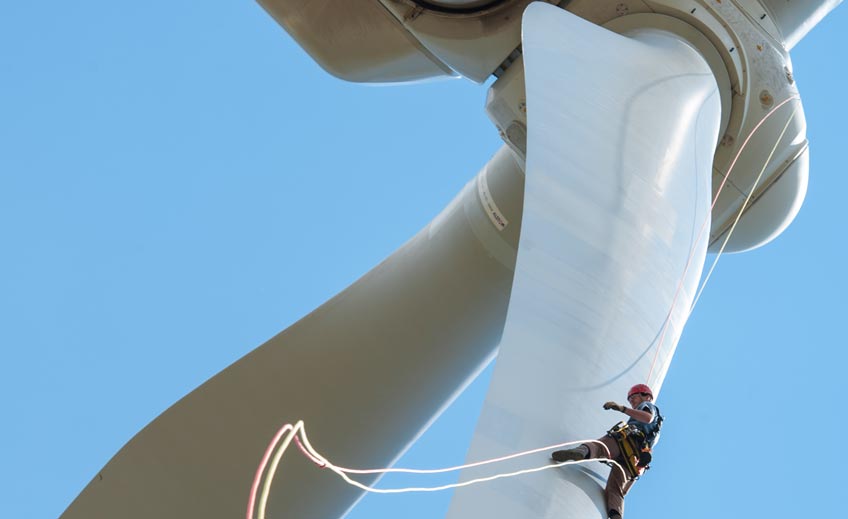Researchers Help Build Wind's Momentum at AWEA Conference
Innovation Propels Wind Beyond Power for 30 Million Homes and Demand for 100,000 Jobs

Higher hub heights make it possible to cost-effectively tap wind resources beyond the reach of today’s typical turbines. Photo by Dennis Schroeder, NREL
Wake steering could increase annual wind plant profits by as much as $1 million, while taller turbine towers could boost capacity factors by as much as 10%. These are just two sets of National Renewable Energy Laboratory (NREL) findings heralded in the spring edition of the Wind R&D Newsletter, as lab researchers prepare to share information on their latest innovations and discoveries at the American Wind Energy Association (AWEA) WINDPOWER 2019 in Houston this week.
NREL experts are exchanging ideas and exploring opportunities for collaboration with fellow researchers and industry leaders to continue the momentum of wind power in the United States and around the world. In the last 10 years, U.S. wind power has tripled, generating enough electricity to power 30 million American homes and creating 114,000 jobs for U.S. workers. Funded by the U.S. Department of Energy (DOE) Wind Energy Technologies Office (WETO), pioneering NREL research has led to the development of components and systems needed to propel wind energy technologies to these new heights.
“In addition to directly supporting our research efforts, WETO and AWEA provide us with invaluable forums for sharing discoveries, so that we can build on each other’s successes and maintain the trend of strong growth for the wind energy sector,” says NREL Wind Laboratory Program Manager Brian Smith.
NREL presentations planned for the AWEA conference include:
- Understanding the Community-Level Economic Impacts Supported by the Rush Creek Wind Farm (Jeremy Stefek)—A look at methods for more accurately assessing and documenting local benefits of wind development, including jobs, local tax payments, and expanded economic activity.
- A Vision for the Power System of the Future with Wind Energy Abundance, from IEA Wind Vision (Eric Lantz)—An overview of challenges that the scientific community still faces and the future of the power system with wind energy as a principal supplier of clean energy around the globe.
- The Role of Wind in a Distributed Energy Future (Ian Baring-Gould)—A mix of presentations, project examples, and discussions breaking down the conventional wisdom on markets for distributed wind.
News from NREL in the WETO-published newsletter includes:
- Wake steering validation field trials suggest that annual energy production gains of 1%–2% are achievable for facilities implementing wind plant-level control.
- A recent study exploring opportunities for taller wind turbine hubs reveals that an increase to 110-meter hub height could boost capacity by 10%.
- Examination of 27 combinations of metrics across 607 wind farms in the United States identified the most useful metric in quantifying long-term energy-generation variability.
- Collaboration by researchers from the United States, Canada, and Mexico on the North American Renewable Integration Study (NARIS) is providing industry with the information needed to plan a reliable long-term cross-border grid with higher penetrations of wind energy sources.
Stories from other national labs spotlight how WETO-funded research is helping safeguard bat populations, creating options to make “supersized” blades cost-competitive, and establishing more accurate simulations for wind plants.
The AWEA WINDPOWER conference brings together more than 7,000 technical and industry experts representing as many as 50 different countries. NREL, WETO, and AWEA have partnered on numerous projects to advance the future of wind power in the United States and around the globe.
Learn more about NREL wind research and read the WETO newsletter.
Last Updated May 28, 2025
